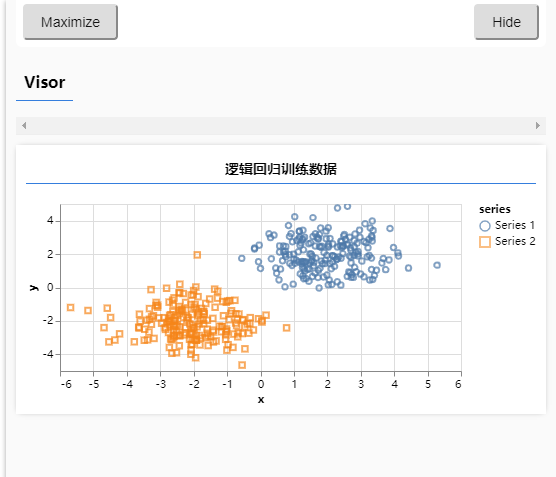# 逻辑回归任务
# 准备数据集
export function getData(numSamples) {
let points = [];
function genGauss(cx, cy, label) {
for (let i = 0; i < numSamples / 2; i++) {
let x = normalRandom(cx);
let y = normalRandom(cy);
points.push({ x, y, label });
}
}
genGauss(2, 2, 1);
genGauss(-2, -2, 0);
return points;
}
/**
* Samples from a normal distribution. Uses the seedrandom library as the
* random generator.
*
* @param mean The mean. Default is 0.
* @param variance The variance. Default is 1.
*/
function normalRandom(mean = 0, variance = 1) {
let v1, v2, s;
do {
v1 = 2 * Math.random() - 1;
v2 = 2 * Math.random() - 1;
s = v1 * v1 + v2 * v2;
} while (s > 1);
let result = Math.sqrt((-2 * Math.log(s)) / s) * v1;
return mean + Math.sqrt(variance) * result;
}
1
2
3
4
5
6
7
8
9
10
11
12
13
14
15
16
17
18
19
20
21
22
23
24
25
26
27
28
29
30
31
32
33
34
2
3
4
5
6
7
8
9
10
11
12
13
14
15
16
17
18
19
20
21
22
23
24
25
26
27
28
29
30
31
32
33
34
# 加载二分类数据
import * as tfvis from "@tensorflow/tfjs-vis";
import { getData } from "./data";
window.onload = function() {
const data = getData(400);
tfvis.render.scatterplot(
{ name: "逻辑回归训练数据" },
{
values: [data.filter(p => p.label === 1), data.filter(p => p.label === 0)]
}
);
};
1
2
3
4
5
6
7
8
9
10
11
12
2
3
4
5
6
7
8
9
10
11
12

# 定义模型结构:带有激活函数的单个神经元
import * as tf from "@tensorflow/tfjs";
import * as tfvis from "@tensorflow/tfjs-vis";
import { getData } from "./data";
window.onload = function() {
const data = getData(400);
tfvis.render.scatterplot(
{ name: "逻辑回归训练数据" },
{
values: [data.filter(p => p.label === 1), data.filter(p => p.label === 0)]
}
);
// ----------------------------------
const model = tf.sequential();
model.add(
tf.layers.dense({
units: 1,
inputShape: [2],
// 激活函数,目的是把值压缩到0,1之间,sigmoid是一个0,1之间的函数
activation: "sigmoid"
})
);
// ----------------------------------
};
1
2
3
4
5
6
7
8
9
10
11
12
13
14
15
16
17
18
19
20
21
22
23
24
2
3
4
5
6
7
8
9
10
11
12
13
14
15
16
17
18
19
20
21
22
23
24
# 损失函数:对数损失(logLoss)
import * as tf from "@tensorflow/tfjs";
import * as tfvis from "@tensorflow/tfjs-vis";
import { getData } from "./data";
window.onload = function() {
const data = getData(400);
tfvis.render.scatterplot(
{ name: "逻辑回归训练数据" },
{
values: [data.filter(p => p.label === 1), data.filter(p => p.label === 0)]
}
);
const model = tf.sequential();
model.add(
tf.layers.dense({
units: 1,
inputShape: [2],
// 激活函数,目的是把值压缩到0,1之间,sigmoid是一个0,1之间的函数
activation: "sigmoid"
})
);
////------------------------------------------
// 损失器采用 logLoss,是对数型的,符合0,1之间 优化器选用adam,可以自动调节
model.compile({ loss: tf.losses.logLoss, optimizer: tf.train.adam(0.1) });
////------------------------------------------
};
1
2
3
4
5
6
7
8
9
10
11
12
13
14
15
16
17
18
19
20
21
22
23
24
25
26
2
3
4
5
6
7
8
9
10
11
12
13
14
15
16
17
18
19
20
21
22
23
24
25
26
# 训练模型可视化操作步骤
import * as tf from "@tensorflow/tfjs";
import * as tfvis from "@tensorflow/tfjs-vis";
import { getData } from "./data";
window.onload = async function() {
const data = getData(400);
tfvis.render.scatterplot(
{ name: "逻辑回归训练数据" },
{
values: [data.filter(p => p.label === 1), data.filter(p => p.label === 0)]
}
);
const model = tf.sequential();
model.add(
tf.layers.dense({
units: 1,
inputShape: [2],
// 激活函数,目的是把值压缩到0,1之间,sigmoid是一个0,1之间的函数
activation: "sigmoid"
})
);
model.compile({ loss: tf.losses.logLoss, optimizer: tf.train.adam(0.1) });
// --------------------------------------------------------------
// 输入数据
const input = tf.tensor(data.map(p => [p.x, p.y]));
const labels = tf.tensor(data.map(p => p.label));
// 训练模型
await model.fit(input, labels, {
batchSize: 40,
epochs: 50,
callbacks: tfvis.show.fitCallbacks({ name: "训练过程" }, ["loss"])
});
// ----------------------------------------------------------------
};
1
2
3
4
5
6
7
8
9
10
11
12
13
14
15
16
17
18
19
20
21
22
23
24
25
26
27
28
29
30
31
32
33
34
35
36
37
2
3
4
5
6
7
8
9
10
11
12
13
14
15
16
17
18
19
20
21
22
23
24
25
26
27
28
29
30
31
32
33
34
35
36
37
# 在页面输入预测的点预测
index.html
<script src="./script.js"></script>
<form action="" onsubmit="predict(this);return false;">
x: <input type="text" name="x">
y: <input type="text" name="y">
<button type="submit">预测</button>
</form>
1
2
3
4
5
6
7
2
3
4
5
6
7
import * as tf from "@tensorflow/tfjs";
import * as tfvis from "@tensorflow/tfjs-vis";
import { getData } from "./data";
import { model } from "@tensorflow/tfjs";
window.onload = async function() {
const data = getData(400);
tfvis.render.scatterplot(
{ name: "逻辑回归训练数据" },
{
values: [data.filter(p => p.label === 1), data.filter(p => p.label === 0)]
}
);
const model = tf.sequential();
model.add(
tf.layers.dense({
units: 1,
inputShape: [2],
// 激活函数,目的是把值压缩到0,1之间,sigmoid是一个0,1之间的函数
activation: "sigmoid"
})
);
model.compile({ loss: tf.losses.logLoss, optimizer: tf.train.adam(0.1) });
// 输入数据
const input = tf.tensor(data.map(p => [p.x, p.y]));
const labels = tf.tensor(data.map(p => p.label));
await model.fit(input, labels, {
batchSize: 40,
epochs: 50,
callbacks: tfvis.show.fitCallbacks({ name: "训练过程" }, ["loss"])
});
// ----------------------------------------------------------
window.predict = form => {
const pred = model.predict(
tf.tensor([[form.x.value * 1, form.y.value * 1]])
);
alert(`预测结果: ${pred.dataSync()[0]}`);
};
// ----------------------------------------------------------
};
1
2
3
4
5
6
7
8
9
10
11
12
13
14
15
16
17
18
19
20
21
22
23
24
25
26
27
28
29
30
31
32
33
34
35
36
37
38
39
40
41
42
43
44
45
2
3
4
5
6
7
8
9
10
11
12
13
14
15
16
17
18
19
20
21
22
23
24
25
26
27
28
29
30
31
32
33
34
35
36
37
38
39
40
41
42
43
44
45